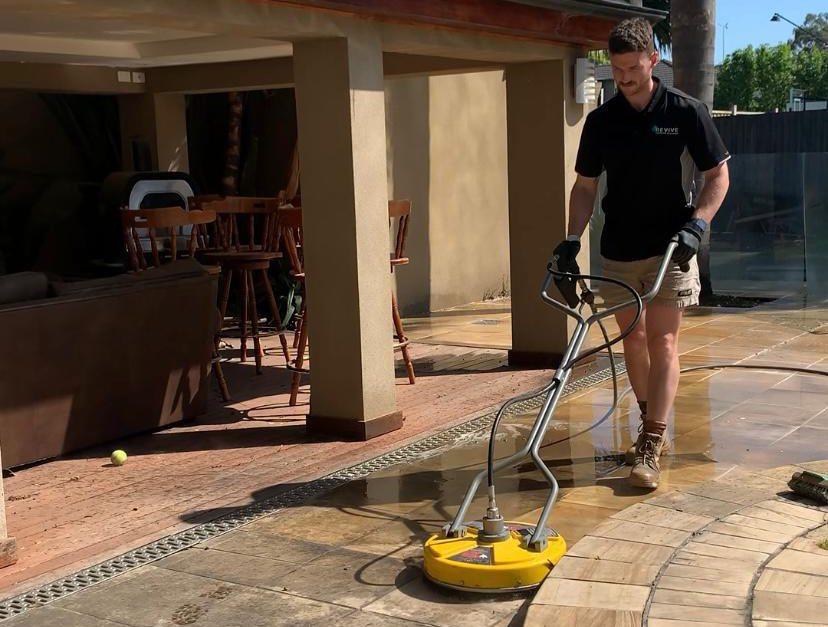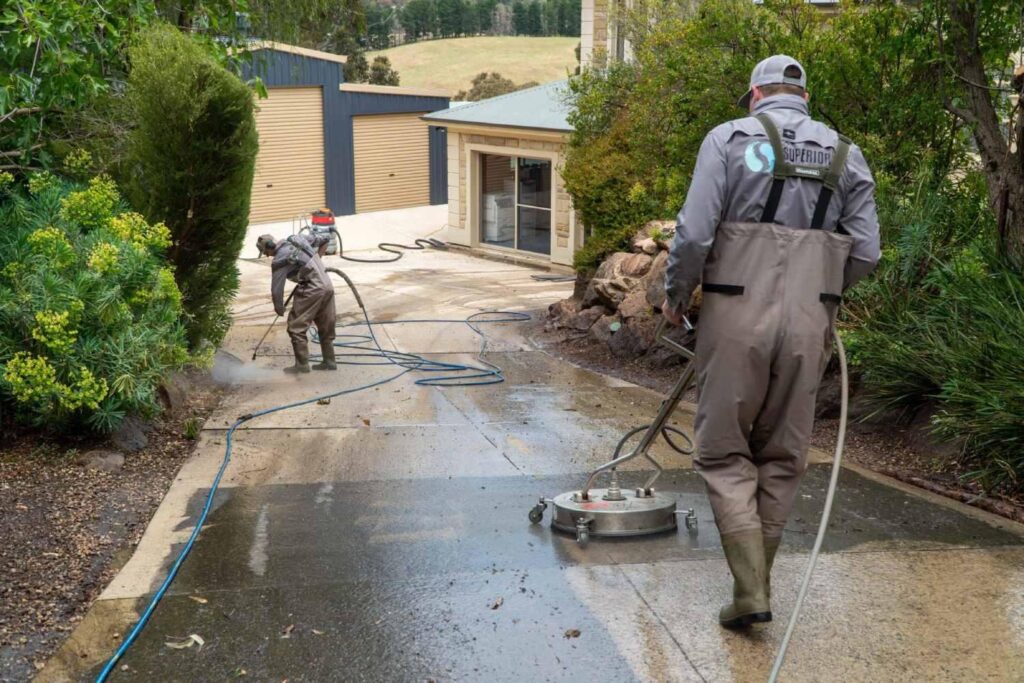That fresh, post-cleaning feeling is unbeatable. It can quickly turn to frustration when your Karcher pressure washer starts sputtering or losing power halfway through the job.
The reality is, skipping basic maintenance can lead to clogged nozzles, stubborn build-up, and worn-out parts much sooner than you might expect.
We’ve seen it firsthand. Powerful machines often become choked by layers of dried detergent, grit, and grime, similar to the very surfaces they are designed to clean.
A quick rinse will not cut it. Proper cleaning keeps your washer performing at its best for longer and can save you from expensive repairs.
For homeowners aiming for perfect curb appeal and property professionals preparing listings, well-maintained tools deliver better results in less time. At Refined Exterior Cleaning, we make sure both your surfaces and your pressure washer remain in peak condition.
Understanding the Importance of Cleaning a Karcher Pressure Washer
Watching your Karcher pressure washer sputter during a clean-up project can be a real mood-killer. The machine needs just as much care as the patios you blast clean. Grime builds up inside slowly-clogging nozzles, blocking filters, and weakening pressure.
With regular cleaning, you preserve the efficiency and reach of your washer. Our team at Refined Exterior Cleaning in Melbourne knows firsthand how poor upkeep leads to weak results and frustrated clients.
Benefits of Regular Cleaning
Keeping your Karcher pressure washer clean improves spray strength and ensures detergent flows smoothly. That strong spray saves time and gives a neater clean on driveways or weather-worn paths. From our daily work around Melbourne homes, we find this routine care prevents delay and lets us focus on result-driven cleaning, not fighting a misfiring machine.
Extend Lifespan and Improve Performance
Any machine breathes longer with proper care; your Karcher is no different. Routine internal and external cleaning prevents corrosion and reduces strain. At Refined Exterior Cleaning, our pressure washers stay powerful through every job because we treat them like tools, not toys. Fewer repairs. Better performance. Simple as that.
Cleaning Frequency and Monitoring
Following the signs-reduced pressure or inconsistent detergent flow means it’s cleaning time. We recommend checking after six hours of use. Here in Melbourne’s changeable weather, that can mean after just one full weekend job. A visual once-over before stowing it away also helps catch grime early.
Safety Measures Before Cleaning
Before tackling internal gunk or spray head grime, staying safe is step one. At Refined Exterior Cleaning, we always secure our gear just like a seasoned tradie would secure a ladder. Don’t rush this part. It keeps fingers and fuses safe.
Unplug and Depressurise
Keep your hands and circuits protected. Always switch the power off and squeeze the trigger to release trapped pressure. This stops unexpected sprays or broken seals. Every time our crew finishes a job, we follow these steps without fail.
Allow Cool Downtime
While running, the motor and pump get hot. Letting it sit for 10–15 minutes before touching makes cleaning comfortable. We find this pause gives just enough time to pack away other gear or prep for another surface.
Wear Protective Gear
Gloves and goggles aren’t just for heavy-duty jobs. They protect you from splashes of detergent or debris inside filters. Melbourne’s unpredictable gusts can carry mist, so we always gear up like it’s standard uniform.
Step-by-Step Internal Cleaning
A deep clean inside your Karcher protects key parts from blockages and pressure drops. It’s not about scrubbing-it’s about knowing where to flush, check, or pop open. We guide our staff on precise, step-ready routines down to the nozzle tip.
Flush Detergent System
Leftover detergent dries into clumps, clogging the mixing valve. Run clean water through the soap tank and hose every couple of uses. We’ve avoided dozens of costly service calls with this tiny five-minute rinse-out step.
Clean the Water Filter
The tiny mesh tucked near the hose intake traps mineral bits and grit. Remove, rinse, and reinstall. Whether it’s a K2 or K4 model, this step’s a must. We remind our crew to do it fortnightly when working consecutive jobs across Melbourne’s suburbs.
Inspect Nozzles and Spray Wand
An unsteady spray stream usually points to a clogged nozzle. We use a brush or a thin needle to pick out debris. Swapping between spray heads often? A quick rinse and shake keeps the flow consistent during back-to-back cleans.
Exterior and Accessory Cleaning Techniques
Outside appearances matter-machines included. A dusty washer tracks dirt into the pump. That’s why our team always finishes a project by thoroughly cleaning and sanitising gear and surfaces. Clean tools make for clean results.
Wipe Down Housing and Wheels
Use a damp cloth to remove splashes, build-up around wheels, or dust hiding in vents. A clean outer shell prevents stubborn grime from creeping deeper inside. This also keeps units looking job-ready.
Rinse and Dry Brushes and Lances
Brushes, turbo lances, or whatever attachments you use – soak and rinse them after each session. Any lodged dirt left behind gets caked. We keep a soft towel handy for a quick dry and repack at every site visit.
Wash Hose and Remove Kinks
Lay the hose flat and roll it loosely after rinsing. Avoid sharp bends or tight folds. Too many twist points strain internal tubing, and you’ll soon face cracking or internal leaks. Treat hoses kindly-they’re your precious pipeline.
Detergents and Cleaning Solutions
Add the right kind of soap, and your pressure washer becomes even more efficient. Choose poorly, and you risk degrading internal parts. Our crew uses cleaners that work hard without wearing things out.
Recommended Detergents
Choose detergents made for pressure washers. They’re low-foam and non-corrosive. Whether you’re washing brick or concrete, always rinse contact areas with fresh water after use. It protects the seals and valves around compression chambers.
Avoiding Damage from Harsh Chemicals
Avoid bleach and solvents, as they break down rubber gaskets and O-rings. We’ve seen trigger wands leak early just from poor detergent choices. Gentle, site-appropriate cleaners offer real value over shortcuts.
Eco-friendly Options
We handpick biodegradable detergents that effectively remove grime without harming gardens or pets. Our motto is “Tough on dirt, gentle on your property.” It’s neighbour-friendly and keeps Melbourne’s green spaces cleaner, too.

Common Troubleshooting During Cleaning
Even with regular care, machines hiccup. Quick fixes and smart checks help avoid disruption. At Refined Exterior Cleaning, we’ve learned that knowing minor repairs beats hauling gear back to base mid-job.
Pressure Drop or Inconsistency
Low pressure often means clogged nozzles or filters. First, confirm your water supply is steady. Next, inspect nozzle tips and filters. Restart slowly to see if the pulse evens out. Don’t overlook silly things-a kinked hose causes drama every time.
Airlocks in the System
If your Karcher starts but won’t produce force, air may be inside. Disconnect the hose and turn on the water flow until it runs solid. Reconnect carefully. It’s like bleeding air out of a radiator-simple and often forgotten.
Leaks or Broken Seals
Seals dry out over time or get pinched during quick clean-ups. Visually inspect joins and the pump bottom. Use pliers gently to tighten any loose collar nuts. For units under heavy seasonal use, consider a yearly seal kit replacement.
Best Practices for Storing After Cleaning
Giving your Karcher a proper send-off after cleaning matters. We treat ours like tools with loyalty-they give back if stored right, especially in Melbourne’s winter chills.
Proper Drainage and Coil Storage
Run the spray trigger until all water is gone. Coil hoses into a relaxed circle. Store indoors if possible, as cold snaps can crack parts. One simple drain step keeps internal lines safe.
Protect from Dust and Moisture
Wrap the unit in a cloth or light tarp. Store above ground to avoid puddle exposure. This protects the motor and pump housing against rust. Less dust always equals less cleaning later.
Seasonal Storage Preparation
Before long breaks, empty the detergent tank, flush lines, and disconnect attachments. A dry core means no swelling or rust inside. Our techs do this after every summer rush season.
Optional Accessories for Easier Maintenance
With the right gear, routine pressure washer upkeep becomes quicker. We’ve tested various add-ons during work across steep driveways, muddy laneways, and long brick facades.
Drain Cleaning Hoses and Extensions
Longer jobs benefit from flexible extension hoses. We also use slimline drain rods that reach into pipe clogs, resulting in less scraping, better control, and no pressure loss at the tip.
Specialised Brushes and Lances
Rotating brushes loosen stubborn debris fast. They work great on textured walls. Lances help reach gutters without scaling ladders-our favourites on two-storey deep cleans.
High-Pressure Nozzle Attachments
Nozzles that pivot or widen spray patterns speed up the application process on large surfaces. These aren’t gimmicks-they match real-world needs. We adjust them daily across walkways or old concrete pads.
The Grit You Don’t See Is the One That Stays
Sometimes, the mess builds slowly, layer by layer, until your pressure washer starts grumbling or smells off, and you notice the problem. That’s when it hits: it needs care, too. Regular upkeep saves you from last-minute breakdowns just before you need it most.
If it’s already making odd noises, clogging up, or just not delivering the power it once did, it’s calling for a deep clean. A few careful steps now mean smoother jobs ahead and less damage down the line.
At Refined Exterior Cleaning Services, we handle pressure cleaning like second nature, including keeping gear like your Karcher in top shape. Reach out today and let us help keep your clean-up crew running strong.
Frequently Asked Questions
How to Clean a Karcher Pressure Washer Nozzle
Turn off your unit. Use a fine pin to remove dirt from the spray tip. Rinse with warm water. Finish by spraying bursts of water once reattached.
How to Clean the Inside of a Karcher Pressure Washer
Flush fresh water through the tank and hose. Remove and wash filters. Check nozzles and detergent mixing areas. Run the machine briefly with clean water only.
How to Use a Karcher K2 or K4 Pressure Washer
Connect the hose and power. Choose a detergent if needed. Select a nozzle suited for the surface type. Squeeze the trigger gently to start. Always aim at the target before pulling full force.
What to Do If Your Washer Doesn’t Start
Check the outlet and cable. Ensure reset buttons aren’t tripped. Look for water supply blocks or internal airlocks. Restart with all parts secure. Call a technician if all checks fail.


